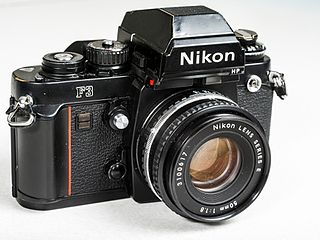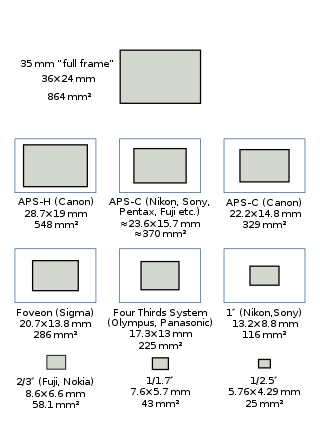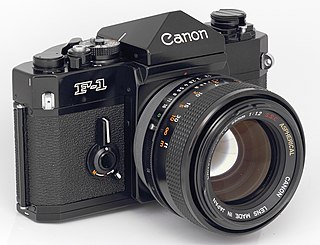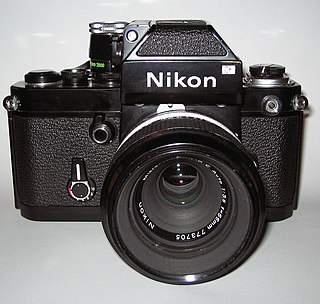
A single-lens reflex camera (SLR) is a camera that typically uses a mirror and prism system that permits the photographer to view through the lens and see exactly what will be captured. With twin lens reflex and rangefinder cameras, the viewed image could be significantly different from the final image. When the shutter button is pressed on most SLRs, the mirror flips out of the light path, allowing light to pass through to the light receptor and the image to be captured.

A camera is an instrument used to capture and store images and videos, either digitally via an electronic image sensor, or chemically via a light-sensitive material such as photographic film. As a pivotal technology in the fields of photography and videography, cameras have played a significant role in the progression of visual arts, media, entertainment, surveillance, and scientific research. The invention of the camera dates back to the 19th century and has since evolved with advancements in technology, leading to a vast array of types and models in the 21st century.

An autofocus (AF) optical system uses a sensor, a control system and a motor to focus on an automatically or manually selected point or area. An electronic rangefinder has a display instead of the motor; the adjustment of the optical system has to be done manually until indication. Autofocus methods are distinguished as active, passive or hybrid types.

A digital single-lens reflex camera is a digital camera that combines the optics and mechanisms of a single-lens reflex camera with a solid-state image sensor and digitally records the images from the sensor.

The Nikon F3 is Nikon's third professional single-lens reflex camera body, preceded by the F and F2. Introduced in March 1980, it has manual and semi-automatic exposure control whereby the camera would select the correct shutter speed. The Nikon F3 series cameras has the most model variations of any Nikon F camera. It is also the first of numerous Nikon F-series cameras to be styled by Italian designer Giorgetto Giugiaro, and to include a red stripe on the handgrip – a feature that would later become a signature feature of many Nikon cameras.

The Canon A-1 is an advanced-level single-lens reflex (SLR) 35 mm film camera for use with interchangeable lenses. It was manufactured by Canon Camera K. K. in Japan from March 1978 to 1985. It employs a horizontal cloth-curtain focal-plane shutter with a speed range of 30 to 1/1000 second plus bulb and flash synchronization speed of 1/60 second. It has dimensions of 92 millimetres (3.6 in) height, 141 millimetres (5.6 in) width, 48 millimetres (1.9 in) depth and 620 grams (22 oz) weight. Unlike most SLRs of the time, it was available in only one color; all black. The introductory US list price for the body plus Canon FD 50 mm f/1.4 SSC lens was $625; the camera body was generally sold with a 30–40% discount.
In photography, through-the-lens metering refers to a feature of cameras whereby the intensity of light reflected from the scene is measured through the lens; as opposed to using a separate metering window or external hand-held light meter. In some cameras various TTL metering modes can be selected. This information can then be used to set the optimal film or image sensor exposure, it can also be used to control the amount of light emitted by a flash unit connected to the camera.

A full-frame DSLR is a digital single-lens reflex camera (DSLR) with a 35 mm image sensor format. Historically, 35 mm was one of the standard film formats, alongside larger ones, such as medium format and large format. The full-frame DSLR is in contrast to full-frame mirrorless interchangeable-lens cameras, and DSLR and mirrorless cameras with smaller sensors, much smaller than a full 35 mm frame. Many digital cameras, both compact and SLR models, use a smaller-than-35 mm frame as it is easier and cheaper to manufacture imaging sensors at a smaller size. Historically, the earliest digital SLR models, such as the Nikon NASA F4 or Kodak DCS 100, also used a smaller sensor.

The Canon F-1 is a 35 mm single-lens reflex camera produced by Canon of Japan from March 1971 until the end of 1981, at which point it had been superseded by the New F-1 launched earlier that year. The Canon FD lens mount was introduced along with the F-1, but the previous Canon FL-mount lenses and older R- series lenses were also compatible with the camera with some limitations. The Canon F-1 was marketed as a competitor to the Nikon F and Nikon F2 single lens reflex cameras by Nikon.

The Nikon F2 is a professional-level, interchangeable lens, 35 mm film, single-lens reflex (SLR) camera. It was manufactured by the Japanese optics company Nippon Kogaku K. K. in Japan from September 1971 to 1980. It used a horizontal-travel focal plane shutter with titanium shutter curtains and a speed range of 1 to 1/2000 second plus Bulb and Time, and flash X-sync of 1/80 second. It had dimensions of 98 mm height, 152.5 mm width, 65 mm depth and 730 g weight. It was available in two colors: black with chrome trim and all black. The F2 was adopted by both casual photographers and professional photographers, the latter of those especially photojournalists covering the later half of the Vietnam War.

The history of the single-lens reflex camera (SLR) begins with the use of a reflex mirror in a camera obscura described in 1676, but it took a long time for the design to succeed for photographic cameras. The first patent was granted in 1861, and the first cameras were produced in 1884, but while elegantly simple in concept, they were very complex in practice. One by one these complexities were overcome as optical and mechanical technology advanced, and in the 1960s the SLR camera became the preferred design for many high-end camera formats.

The Canon EOS RT is a 35mm single-lens reflex camera produced by Canon and sold from 1989 to 1992. The camera is essentially an EOS 630/EOS 600 with a pellicle mirror. Only 25,000 were manufactured at the end of the EOS 630 production run, so the EOS RT was technically "out of production" before it ever went on sale.

The EOS-1N is a 35mm single lens reflex (SLR) camera body produced by Canon. It was announced by Canon in 1994, and was the professional model in the range, superseding the original Canon EOS-1. The camera was itself superseded by the EOS-1V in 2000.

The Canon Pellix is a manual-focus single-lens reflex (SLR) camera released in 1965 that uses a stationary half-silvered mirror behind which a metering cell is raised during light level metering.

Live preview is a feature that allows a digital camera's display screen to be used as a viewfinder. This provides a means of previewing framing and other exposure before taking the photograph. In most such cameras, the preview is generated by means of continuously and directly projecting the image formed by the lens onto the main image sensor. This in turn feeds the electronic screen with the live preview image. The electronic screen can be either a liquid crystal display (LCD) or an electronic viewfinder (EVF).

This article details lensesfor single-lens reflex and digital single-lens reflex cameras. The emphasis is on modern lenses for 35 mm film SLRs and for "full-frame" DSLRs with sensor sizes less than or equal to 35 mm.

The Canon EOS 500D is a 15-megapixel entry-level digital single-lens reflex camera, announced by Canon on 25 March 2009. It was released in May 2009. It is known as the EOS Kiss X3 in Japan, and as the EOS Rebel T1i in North America. It continues the Rebel line of mid-range DSLR cameras, is placed by Canon as the next model up from the EOS 450D, and has been superseded by the EOS 550D (T2i).

Single-lens translucent (SLT) is a Sony proprietary designation for Sony Alpha cameras which employ a pellicle mirror, electronic viewfinder, and phase-detection autofocus system. They employ the same Minolta A-mount as Sony Alpha DSLR cameras.

The EOS-1 is a 35mm single lens reflex (SLR) camera body produced by Canon. It was announced by Canon in 1989, and was the professional model in the range. The camera also had a successor, the Canon EOS-1N, in 1994.

The Sony Alpha 99 was announced by Sony on September 12, 2012. It was the flagship Sony DSLR camera and of the Sony Alpha SLT line until late 2016 when it was replaced by the Sony α99 II.


















